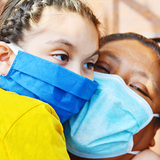
No one knows exactly when the COVID-19 pandemic will end. However, with more than 18 months of data, we have a good understanding of where COVID-19 will linger in the coming months. Healthcare workers have been, and will continue to be, at high risk of exposure to the coronavirus. On June 21, 2021, as infection rates have fallen and vaccination rates have increased, the Occupational Safety and Health Administration released its belated COVID-19 Emergency Temporary Standard after several states issued their own ETS. The OSHA COVID-19 ETS takes what we know, builds on existing occupational standards and targets mandates where the coronavirus is most likely to place healthcare workers at risk.
What are the risks to healthcare workers?
We now know the virus that causes COVID-19 is transmitted through the air when an infected person exhales, talks, sings, shouts, coughs or sneezes nearby an uninfected person. Because sick people go to healthcare facilities to seek care, as long as there is community spread of COVID-19, healthcare workers will continue to be exposed to it. The full extent of work-related exposures, illnesses and deaths from COVID-19 across all occupations is not yet fully understood. However, we do know healthcare workers are at increased risk of coronavirus exposure with increased COVID-19 infections among front-line healthcare workers and elevated age-adjusted COVID-19 mortality among healthcare workers. We also know implementation of infection control protocols, like masking, testing, physical distancing and quarantine of infected healthcare workers can reduce the risk to healthcare workers and patients.
Is the ETS entirely new and novel?
While onerous, the OSHA COVID-19 ETS does not impose entirely new and novel requirements on employers; however, some have said the ETS is “too much, too late” and have advocated for a less burdensome approach. The 1970 OSHA Act’s General Duty Clause already requires employers to provide a work environment “free from recognized hazards that are causing or are likely to cause death or serious physical harm.” Existing OSHA standards already require employers to provide appropriate personal protective equipment and to train employees on the section, donning, doffing, care and maintenance of PPE based on exposure risks. Many of the elements of the new OSHA COVID-19 Plan mirror existing requirements for an Exposure Control Plan for bloodborne pathogen risks.
Which healthcare workplaces are covered by the ETS?
The OSHA COVID-19 ETS does not apply to all healthcare workers, the ETS limits its application to those healthcare settings where COVID-19 cannot be effectively kept out of the workplace through a combination of employee vaccination and nonemployee screening. For covered workplaces, the OSHA COVID-19 ETS requires a COVID-19 plan and employee, patient and visitor screening to control the entry of COVID-19 into the workplace. If COVID-19 exposure risks can be eliminated in well-defined areas of the workplace (COVID safe zones), the PPE, physical distancing and shielding requirements of the ETS do not apply to fully vaccinated employees in these COVID safe zones. In all other healthcare areas in covered workplaces, the ETS requires appropriate PPE, physical distancing, sanitation and physical barriers to reduce COVID-19 exposure risks. For most covered hospitals, the ETS will apply in full to all employees and in all areas of the hospital (with some limited PPE, physical distancing and physical barrier exceptions in COVID safe zones).
The OSHA COVID-19 ETS applies to healthcare workplaces where employee vaccination and nonemployee screening cannot effectively prevent people with suspected or confirmed COVID-19 from entering. These covered workplaces must have a COVID-19 Plan and must implement PPE, physical distancing, cleaning and physical barrier protections to protect its workers in areas where they may be exposed to COVID-19. Training, record keeping, contact tracing/testing, medical removal protection benefits, COVID-19 vaccination support and reporting requirements apply to employers with covered workplaces under the ETS. Screening protocols for employees, patients and visitors must exist so appropriate transmission-based precautions may be timely implemented.
Brent Ibata, PhD, JD, FACHE, is a healthcare executive, attorney and expert in the built environment and public health. He is the author of the book Public Health Law and the Built Environment.




















